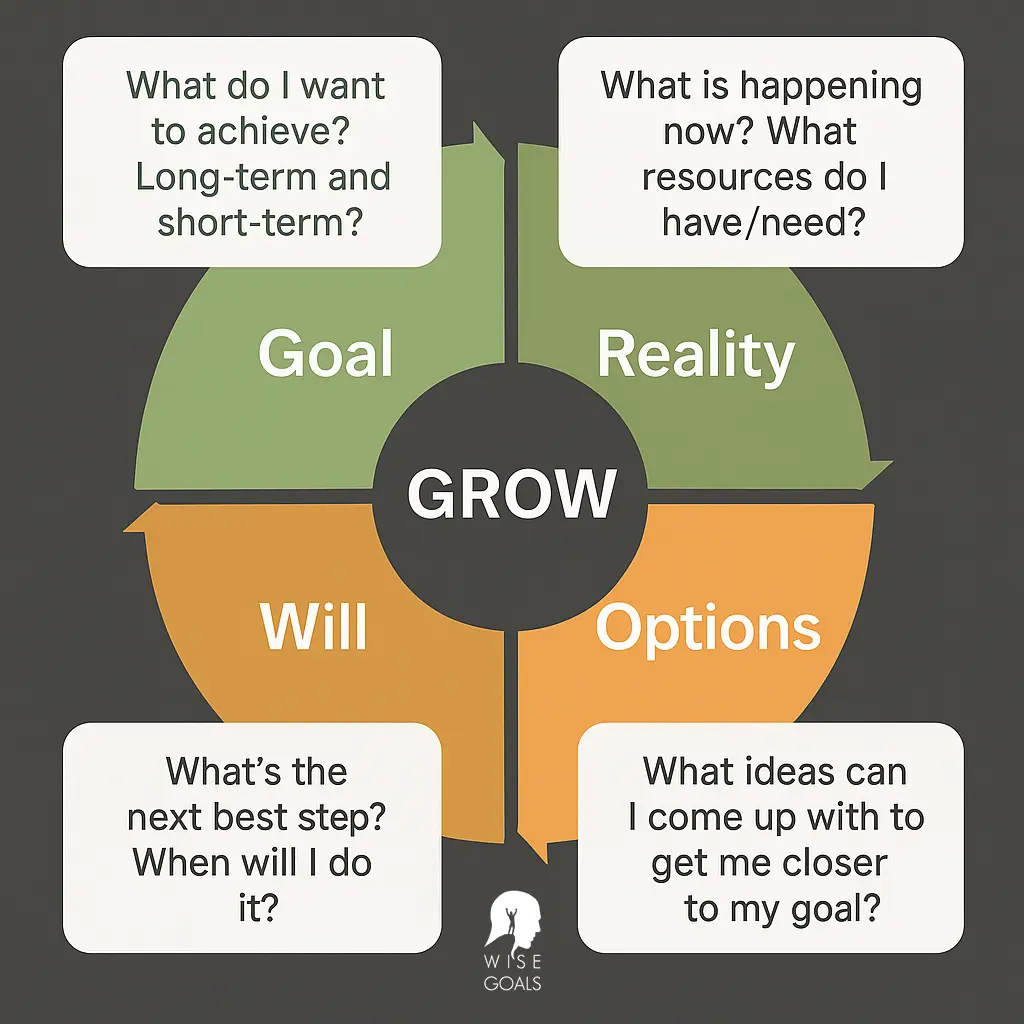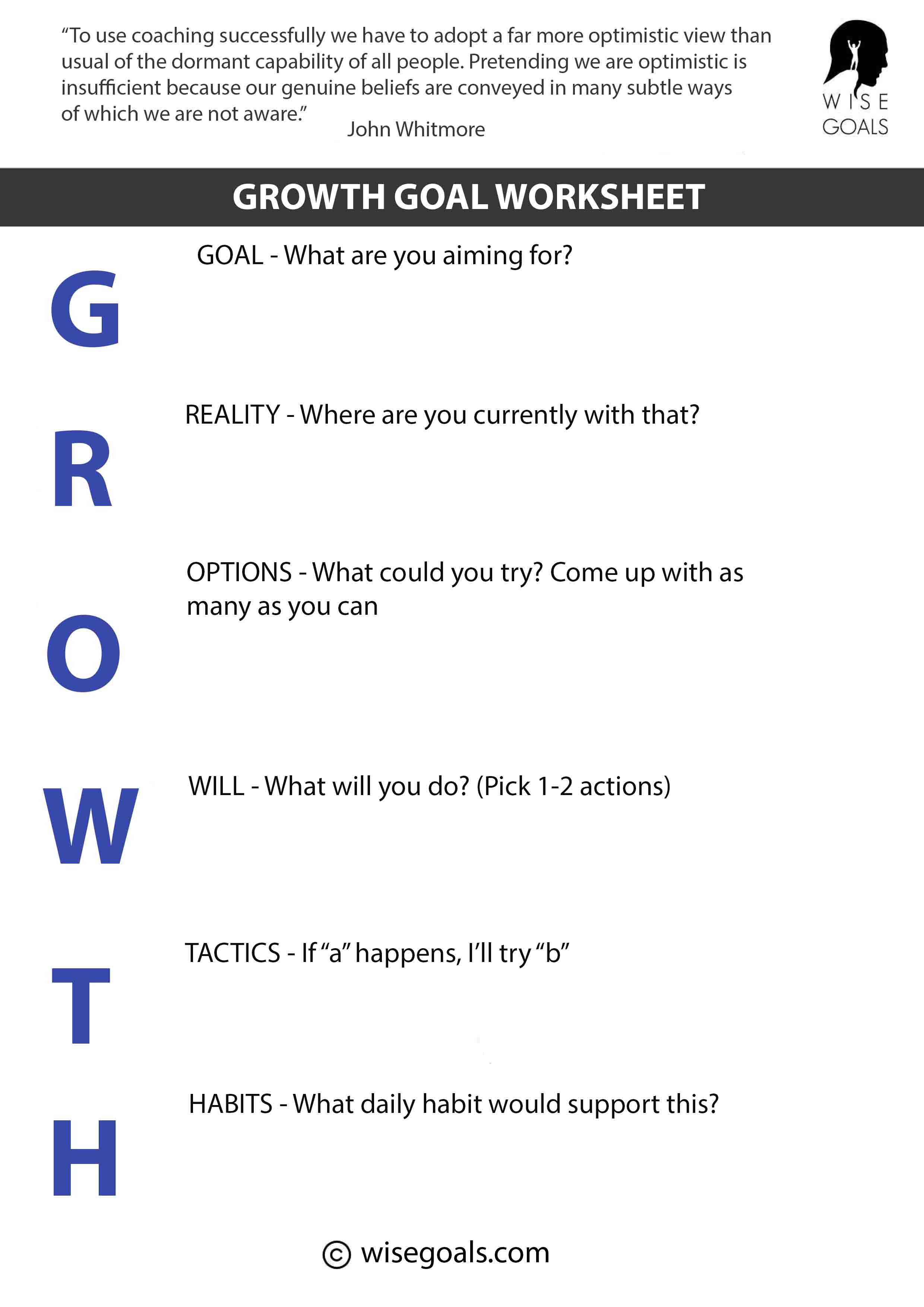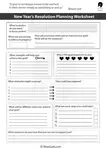- Home
- All About Goal Setting
- GROW Model for Goal Setting
The GROW Model: A Simple (But Powerful) Way to Unstick Your Goals
Used by coaches worldwide—now adapted for your personal growth.
The GROW model (Goal, Reality, Options, Will) cuts through overwhelm by turning abstract goals into clear action steps. Originally developed for coaching, it’s perfect for self-reflection, and planning goal progress—because it:
✅ Reduces pressure by breaking goals into smaller, manageable pieces.
✅ Surfaces hidden obstacles (like unhelpful assumptions or resource gaps).
✅ Focuses on agency—you choose the path that fits your reality.

How to Use GROW/GROWTH for Personal Goals
1. Goal: What Do You Really Want?
Ask:
- “What am I aiming for?"
- "Where am I going toward?"
- "What's the outcome, or performance I want to think about?"
2. Reality: Where Are You Starting?
Ask:
- “What’s actually happening now with that?” (Be honest, not judgmental.)
- “What’s helped/hindered me before?”
- "What resources and strengths support me?"
3. Options: What Could You Do?
Brainstorm: List every idea, even silly ones. Then ask:
- “Which option feels most doable and aligned?”
- “What’s one tiny step I haven’t tried?”
4. Will: What Will You Do?
Commit: Pick 1-2 actions and specify:
- When/Where? (e.g., “Sunday 9 AM, kitchen table”).
- How will you remember? (Alarm? Accountability buddy?).
5. (GROWTH) Tactics + Habits
- Tactics: “What’s my Plan B if motivation dips?” (e.g., “If I skip yoga, I’ll do a 5-minute stretch instead.”)
- Habits: “What daily/weekly ritual would support this?” (e.g., “Every morning, I’ll write my top priority.”)
Real-Life GROW(TH) Examples
1. Career: Transition to Freelance Work
Goal:
"Build a freelance business in instructional design within 6 months, working 20 hours/week."
Reality:
- Current job drains energy; skills exist but no portfolio.
- Strengths: Organized, good at explaining concepts.
- Obstacles: Perfectionism, fear of inconsistent income.
Options:
- Create 3 portfolio pieces using past work.
- Take a part-time course on freelancing.
- Network in niche Facebook groups 2x/week.
- Start with 1-2 small clients to build confidence.
Will:
- Action: "This Sunday, I’ll outline my first portfolio piece."
- Accountability: Share progress with a colleague every Friday.
Tactics (Plan B):
- If procrastinating: "I’ll work for just 15 minutes—often that’s enough to start."
- If overwhelmed: "I’ll focus only on one portfolio piece, not all three."
Habits:
- Weekly: "Every Monday, I’ll email one potential client."
- Daily: "After breakfast, I’ll write my top freelance task for the day."
2. Health: Manage Chronic Pain
Goal:
"Reduce back pain to comfortably sit at my desk for 4 hours/day."
Reality:
- Sedentary job; past attempts fizzled due to all-or-nothing thinking.
- Strengths: Access to physical therapy exercises.
- Obstacles: Inconsistent routine, frustration with slow progress.
Options:
- Do 10-minute chair stretches every 90 minutes.
- Try water aerobics 2x/week (gentler on joints).
- Use a standing desk for 30-minute intervals.
- Track pain triggers in a journal.
Will:
- Action: "Tomorrow, I’ll set phone alarms for stretch breaks."
- Accountability: Text my sister after each stretch session.
Tactics (Plan B):
- If too sore: "I’ll do 2 minutes of deep breathing instead."
- If busy: "I’ll stretch during Zoom calls (camera off)."
Habits:
- Daily: "After lunch, I’ll walk for 10 minutes."
- Weekly: "Sundays, I’ll plan meals to reduce inflammation."
3. Wellbeing: Improve Sleep
Goal:
"Fall asleep within 30 minutes and wake up rested 5 days/week."
Reality:
- Currently takes 1-2 hours to fall asleep; phone use in bed.
- Strengths: Enjoy herbal tea, have blackout curtains.
- Obstacles: Late-night work anxiety, caffeine after 3 PM.
Options:
- Read fiction (not screens) 30 minutes before bed.
- Try a 5-minute body scan meditation.
- Move caffeine cutoff to 12 PM.
- Write a "worry list" an hour before bed.
Will:
- Action: "Tonight, I’ll charge my phone outside the bedroom."
- Accountability: Track sleep quality in a bedside notebook.
Tactics (Plan B):
- If anxious: "I’ll listen to a boring podcast to distract my mind."
- If restless: "I’ll do 5 minutes of gentle yoga in bed."
Habits:
- Evening: "At 9 PM, I’ll brew caffeine-free tea as a sleep cue."
- Morning: "Open curtains immediately to reset circadian rhythm."
Free Download: GROW/GROWTH Worksheet

A fillable PDF with guided prompts for your goals.
Frequently Asked Questions
"What is the GROW model for goal-setting?"
"What is the GROW model for goal-setting?"
"The GROW model is a 4-step coaching framework: Goal (define your aim), Reality (assess your situation), Options (brainstorm paths), and Will (commit to action). It’s designed to simplify overwhelming goals into manageable steps."
"How is GROWTH different from GROW?"
"How is GROWTH different from GROW?"
"GROWTH adds Tactics (backup plans for obstacles) and Habits (supportive routines) to the original GROW model. This makes it ideal for long-term goals, like building a freelance career or improving sleep hygiene."
"Can I use GROWTH without a coach?"
"Can I use GROWTH without a coach?"
"Absolutely! Our free worksheet walks you through each step with prompts and examples. It’s self-guided and designed for real-life challenges—download it here to start."
"What if I get stuck on the ‘Reality’ step?"
"What if I get stuck on the ‘Reality’ step?"
"Try breaking it into smaller questions: ‘What’s working now?’, ‘What’s one resource I already have?’ Be kind to yourself—this step is about growing awareness, not judgment. Any question that adds more to your awareness about the current reality is useful"
"What if I can’t think of any options?"
"What if I can’t think of any options?"
"Try these tricks:
- Ask the opposite: ‘What would make this problem worse?’ (Then flip it).
- Steal ideas: Borrow from how you’ve solved similar past challenges.
- Start tiny: ‘What’s one thing that could move me 1% forward?’
"What if I’m stuck deciding on a first action?"
"What if I’m stuck deciding on a first action?"
"Use the ‘5-Minute Test’:
- Write down 2-3 possible actions.
- Ask: ‘Which feels least draining to do for just 5 minutes?’
- Start there—momentum often follows."
"What is TGROW? How does it differ from GROW?"
"What is TGROW? How does it differ from GROW?"
"TGROW adds a Topic step before Goal, helping clarify what to focus on when you feel scattered. It’s ideal for managing overwhelm:
- Topic: ‘What area of life is most interesting to start with?’ (e.g., career, sleep, relationships).
Example: Topic → Health → Goal → ‘Sleep 7 hours nightly’.
"Do I need to do GROW in order?"
"Do I need to do GROW in order?"
"The GROW model is designed to flow from Goal to Will, but it’s flexible. Here’s how to adapt it:
• Traditional path: Works best when you have clear focus (Goal → Reality → Options → Will)
• Reality-first: Helpful when feeling stuck or overwhelmed (start with honest assessment)
• Options-first: Useful when needing creative momentum (brainstorm before refining goals)
• Will-first: Great for quick wins (pick one action to build confidence)
The framework meets you where you are and it's good to be able to use it flexibly as both a coach and when self-coaching"
Want Professional Support?
- Contact me with your GROW answers—I’ll help you troubleshoot.
- Book a free coaching consultation.
- Home
- All About Goal Setting
- GROW Model for Goal Setting
Who I'm Affiliated With
I'm proud to be part of professional networks that value evidence-based practice, inclusion, and social impact.



